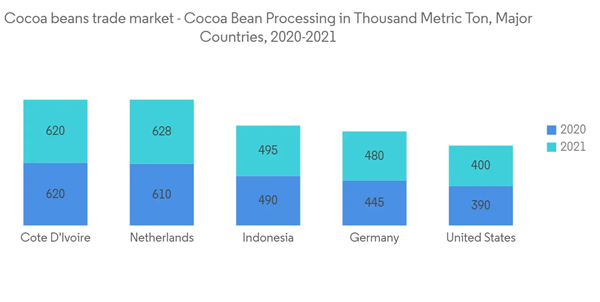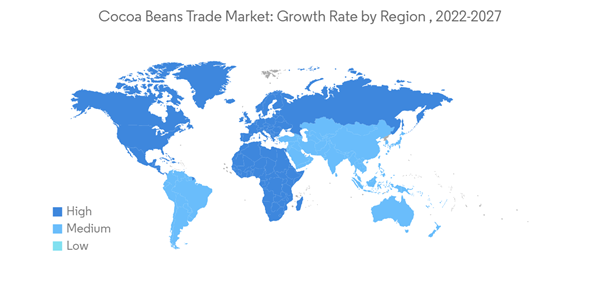Key Highlights
- Cocoa beans are a well-known and profitable cash crop. Cocoa beans have been utilized for ages in a variety of applications and have a strong market demand. These beans have a variety of health benefits and other advantages. As a result, cocoa beans are in great demand as they are widely used in the food and beverage, confectionery, and cosmetic industries. The product finds application in industries such as functional food and beverage, confectionery, pharmaceuticals, and cosmetics. There has been a rising demand for chocolate variants, such as milk chocolate, brownies, and dark chocolate, across the world.
- The world's largest cocoa producer, Cote d'Ivoire produces around 2.2 million metric ton of cocoa beans annually, followed by Ghana, Indonesia, and Nigeria, and accounts 38% of all cocoa bean production worldwide. The national economy is heavily dependent on cocoa prices, and a major amount of the export earnings come from the export of cocoa beans.
- The major producer and exporters of chocolate are in Europe. Because European consumers source cocoa beans of various quality and origins to meet the need of the cocoa and chocolate industries, the European cocoa market is quite diverse. In Europe, 5.0 kilograms of chocolate are consumed on average each person. The coating is becoming increasingly important in processing vegetables, fruits, and cereals for increased flavor, which is expected to drive product demand.
Cocoa Beans Market Trends
Wide Application of Cocoa in Different End-user Industries
Cocoa beans have been used for centuries in a variety of applications and have a high market demand.These beans exhibit several health benefits and other properties. Thus, high demand is reported for cocoa beans as they are used on a large scale in the food and beverage, confectionery, and cosmetics industries. Germany, Belgium, Italy, and Poland are the top four producers of chocolate in the world. These four countries account for more than 40% of global chocolate exports.Cocoa is used in a variety of industries, including confectionery and baking, as a flavoring and coloring agent.The chocolate industry currently represents the biggest end-user of cocoa. The enormous consumption and production of chocolates explain the increasing appetite for cocoa, making cocoa the most widely consumed flavor in the food and beverage industry.
As sales of chocolate in its various forms continue to soar, it will increase the demand for cocoa-processed products, such as cocoa butter and cocoa liquor, significantly. The top four countries that make the world's best chocolate are Belgium, Switzerland, Ecuador, and the United Kingdom. The launch of premium chocolates and the use of chocolate as a flavor in cereals, candies, bars, baked products, syrups, coatings and fillings, and beverages are expected to bode well for the global cocoa market.
Cote D'lvoire leads the Export of Cocoa Beans
High demand for cocoa beans from the chocolate industry (inclusive of both white and dark chocolate) and the surge in demand for premium/super-premium, single-origin, and certified chocolate boost the market for cocoa beans worldwide.Additionally, with the ongoing consumer inclination toward sustainably sourced food and beverage products worldwide, chocolate consumers actively seek sustainably produced and sourced chocolate. Chocolate manufacturers, such as Mondelez, Nestle, and Hershey's, gain an advantage by getting their chocolates/cocoa-derived ingredients certified by agencies like Cocoa Horizons and the Rain Forest Alliance (e.g., Nestle). These chocolate manufacturers offer a wide range of luxury handmade chocolates to create a sensory experience in fine chocolate by combining classic and unusual flavors with premium and fine-flavor single-origin cocoa.
Cote D'lvoire was the leading cocoa bean exporter in 2021, with an export value of $4,727.3 million and a 42.9% share.This is followed by Ghana, Cameroon, and Nigeria, which share 16.1%, 5.6%, and 5.1%, respectively, of the global cocoa exports.
The demand for fine-flavor cocoa has increased significantly.Ultra- and high-end cocoa beans are used for gourmet and regular chocolates, while low-fine cocoa beans are used for regular premium chocolates, especially in countries like the Netherlands, the United Kingdom, Brazil, the United States, China, and Canada. Switzerland is the largest consumer of chocolate in the world. The average per capita is 19.4 pounds, followed by Germany, Ireland, the United Kingdom, and Sweden.
The Netherlands, the United States, and Germany are the key destinations for cocoa, together holding about 41% of the global import. In 2021, the Netherlands imported a total value of USD 1.9 billion (712,261 thousand metric ton) from the world in cocoa and cocoa preparations. Cote d'Ivoire is the country's leading supplier. In 2021, Cote d'Ivoire supplied 275.7 thousand metric tons of cocoa and cocoa preparations.
Additional Benefits:
- The market estimate (ME) sheet in Excel format
- 3 months of analyst support
This product will be delivered within 2 business days.










